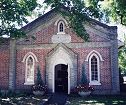Little Trinity Church is located on King Street east of Parliament Street. The historical plaque on the building reads as follows: “Founded in 1842, this is the oldest surviving church in the city of Toronto. Under the patronage of the Right Reverend John Strachan, first Anglican Bishop of Toronto, funds were raised to start construction in 1843. Its first rector was the Rev. W.H. Ripley, and regular services commenced on February 18, 1844. Attended largely by industrial workers, it was known as “The Poor Man’s Church”, although such prominent citizens as William Gooderham, James Worts, Joseph Shuter, William Cawthra and Alexander Dixon were associated with the church in its early days. Gutted by fire in 1961, it has been restored to its early proportions and is a good example of early Gothic Revival architecture.”
Enoch Turner School is located just south of Little Trinity Church on Trinity Street, hence its inclusion on this page. The historical plaque reads: “The Enoch Turner School, 1848. This schoolhouse, the oldest remaining in Toronto, was built at the expense of Enoch Turner, a wealthy brewer, as a “free school” for the Anglican parish of Trinity and adjoining parts of St. Lawrence Ward. An Act of 1847 had made free common schools possible in towns and cities of Canada West, but the municipal council of Toronto had refused to establish them. Enoch Turner’s school was the first free school in the city. In 1851 the Toronto Board of Education took over “Trinity Street School” as one of the regular free schools for boys and girls and it continued as such for more than thirty years. Since then it has been used as a Sunday school and for community activities.”
St. James’ Cathedral is located at the northeast corner of King and Church Streets. The historic plaque outside the church reads: “York’s first church was built here in 1803-07 with the aid of public subscriptions and a government grant. That frame building was enlarged in 1818-19 and replaced by a larger one in 1831. This first incumbent was the Rev. George Okill Stuart, who served from 1800 to 1812 when he was succeeded by the Rev. John Strachan, later first bishop of Toronto. The second church was burnt in 1839. Toronto’s first cathedral was then erected on this site but was destroyed in the great fire of 1849. The present cathedral was begun in 1850, opened for divine service in 1853, and completed in 1874.”
St. James-the-less Chapel is located inside the main gates of St. James’ Cemetery, on Parliament Street near Danforth Avenue. In the early years of Toronto’s existence, burials took place on the grounds of St. James’ Cathedral (King and Church), and although the cemetery at that location has long been disused and no markers are visible, the remains of some of York’s earliest residents lie beneath the parking lot. (some of the markers can be seen inside the vestibule of St. James’ Cathedral) The historical plaque outside St. James-the-less Chapel reads: “In its vigorous, harmonious composition, this small funeral chapel is a splendid example of High Victorian Gothic design. Its sense of strength and spirituality is derived from the subtle contrast of its stone walls, enveloping roofs, and soaring spire. The chapel was erected in 1860 to plans by Cumberland and Storm, one of Toronto’s leading 19th-century architectural firms. Situated on a slight rise, St. James is enhanced by the picturesque setting of its cemetery, which was opened in 1844 and is the oldest established cemetery in the city.”
Located at Winchester and Sumach Streets, the Necropolis (literally “city of the dead”) began operating in 1850. It replaced Toronto’s first non-sectarian burial ground, Potter’s Field, which closed in 1855 due to the rapid growth of the city and the cemetery’s location at Yonge and Bloor. The historical plaque on the Necropolis Chapel reads: “The Chapel at the Toronto Necropolis, together with adjoining entry pavillion and superintendent’s office and residence constitute one of the finest examples of Gothic Revivial architecture in Canada. The unique composition of buildings was designed by architect Henry Langley in 1872. The Chapel, whose arch is the most prominent decorative feature, has a distinctly Gothic motif, including the large arched front stained glass window lighting the nave and the arched rose window of stained glass lighting the sanctuary and chancel. An unique aspect of the chapel’s architecture is the placement of the bell tower at the rear, over the sacristy, a sensible design for funeral processions entering through the porch and passing through the large nave to the chancel and finally through the sacristy to the cemetery grounds. Henry Langley, a Toronto architect, was noted for his use of Gothic Revival style in churches. He died in 1906 at the age of seventy, and was buried in the Toronto Necropolis (section O, Lot 255).”



